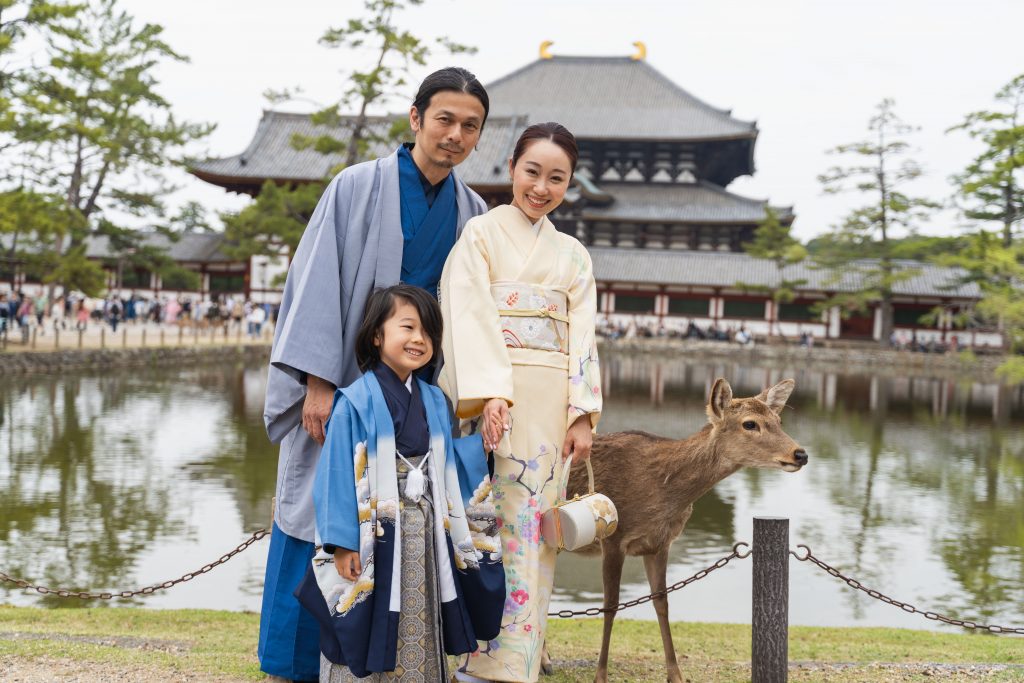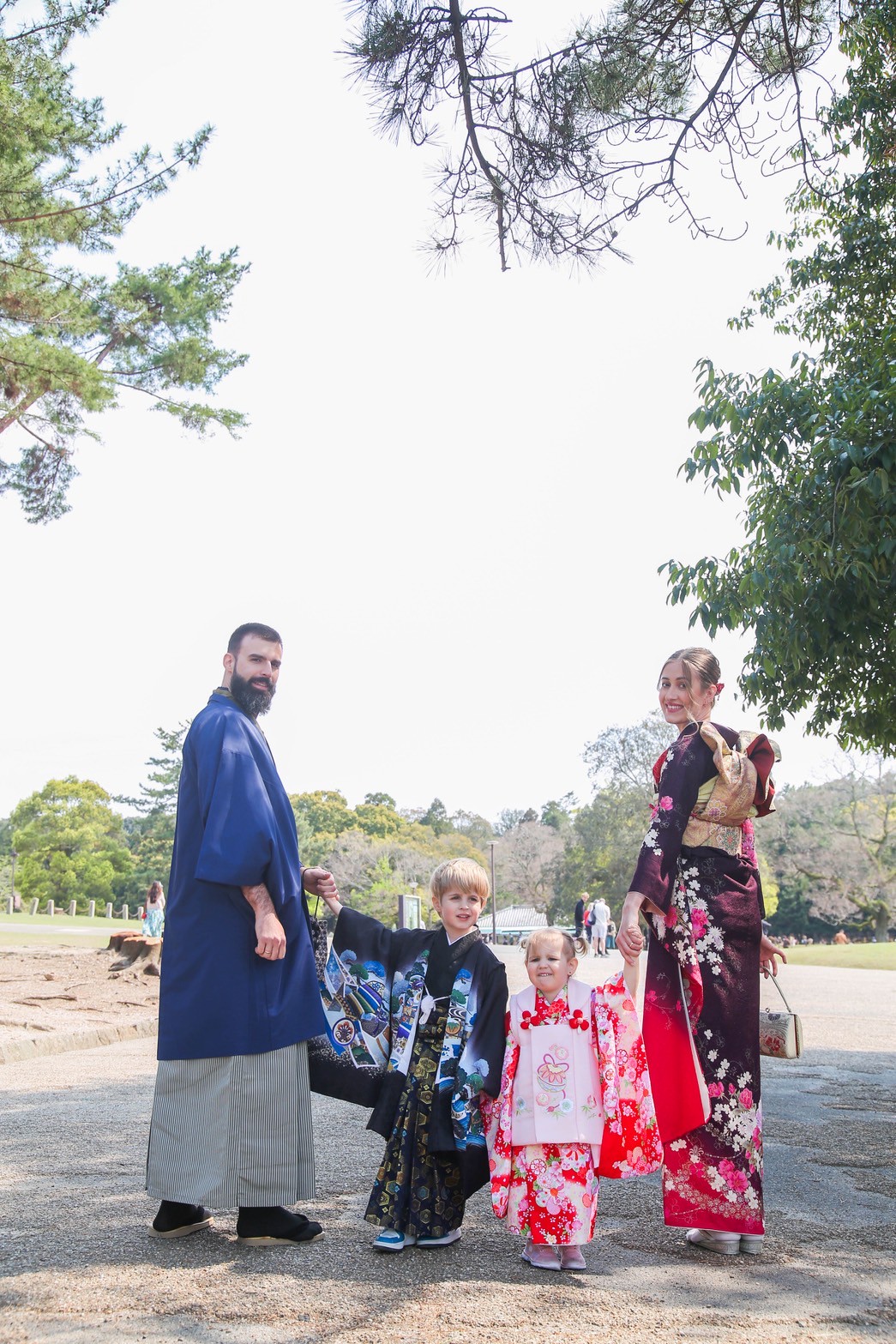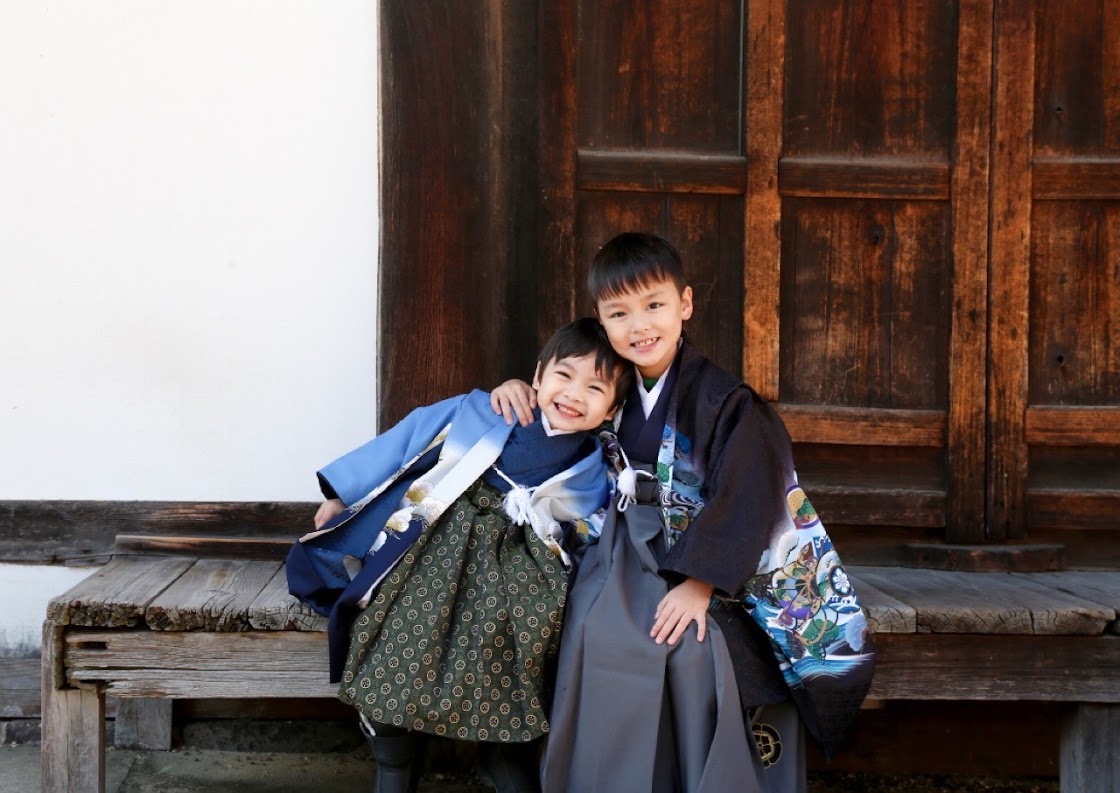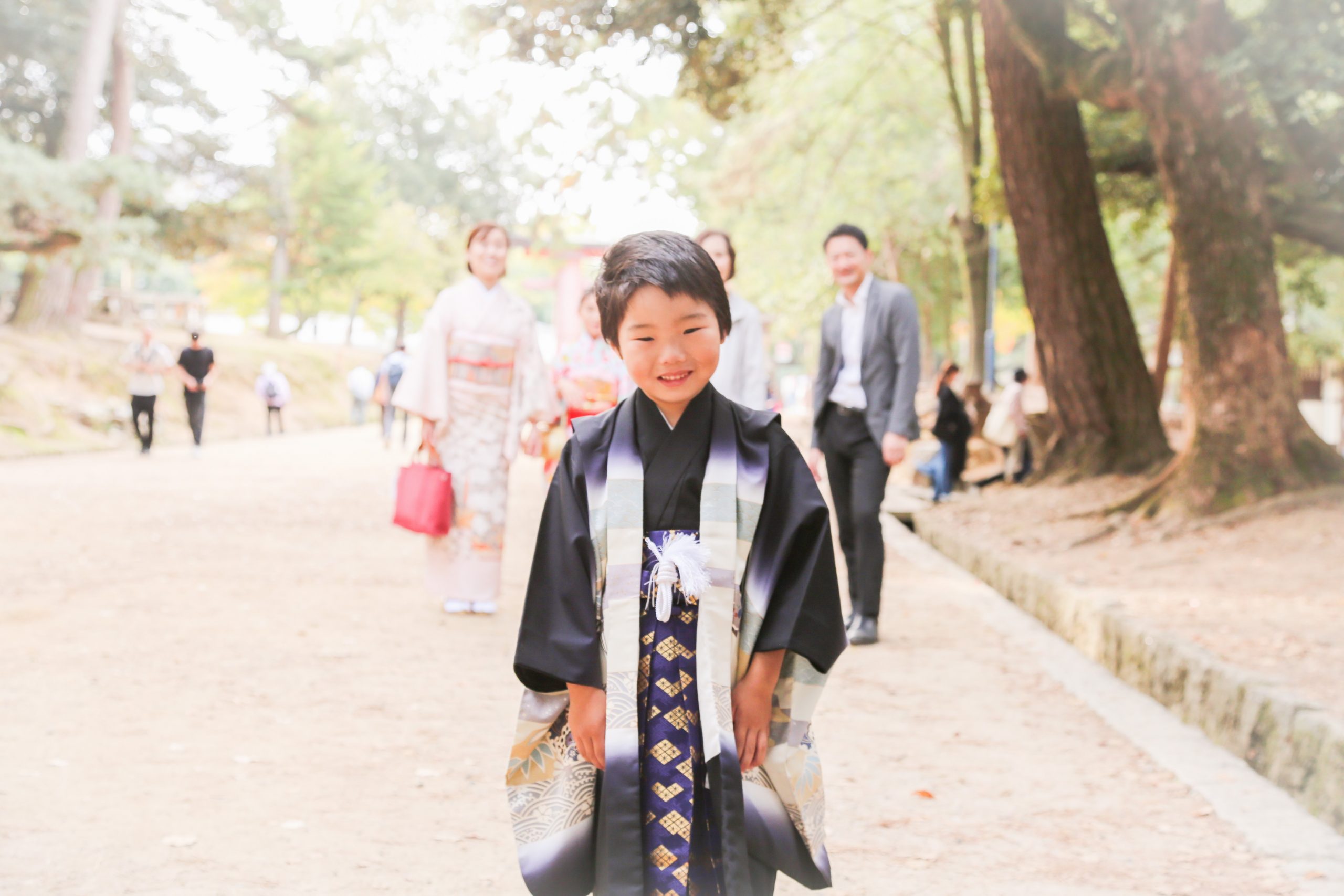Blog / Experiences
Daily life of Waplus Nara

Hello and welcome from Waplus Nara – our kimono rental shop at the Nara Park Bus Terminal
As October begins, the air in the mornings and evenings has started to feel refreshingly crisp 🍁🍂
It’s the perfect time of year to explore, with comfortable daytime temperatures ideal for sightseeing 🎶
In the Nara Park area, more and more visitors are enjoying interactions with the friendly deer, or walking through historic sites like Todai-ji Temple and Kasuga Taisha Shrine dressed in elegant kimono 👘✨
One of the most cherished autumn traditions in Japan is Shichi-Go-San (七五三), celebrated annually on November 15th.
This special event is held to pray for the healthy growth and happiness of children aged 3, 5, and 7 — a beautiful part of Japanese cultural heritage 🎵
In this blog post, we’ll take a closer look at the meaning and origin of Shichi-Go-San, and also introduce a convenient and beautiful kimono rental option available at our shop, Waplus Nara – Nara Park Bus Terminal Store, perfect for celebrating Shichi-Go-San in Nara ❣❣
If you’re thinking,
✨ “We’d love to celebrate Shichi-Go-San in Nara,” or
✨ “We’re looking for a kimono rental shop for Shichi-Go-San,”
then be sure to read all the way to the end! (⋈◍>◡<◍)。✧♡

The History and Meaning of Shichi-Go-San|Why Celebrate at Ages 3, 5, and 7?
What is Shichi-Go-San (七五三)?
Shichi-Go-San, which literally means “Seven-Five-Three,” is a traditional Japanese celebration held every year on November 15th.
This special day honors the healthy growth and well-being of children at the ages of 3, 5, and 7.
Origins in the Heian Period
The roots of Shichi-Go-San go back to the Heian period (794–1185), when three important coming-of-age ceremonies were performed in the imperial court:
- Kamioki (髪置き) at age 3: when children were allowed to start growing out their hair.
- Hakamagi (袴着) at age 5: when boys began wearing the traditional hakama trousers.
- Obitoki (帯解き) at age 7: when girls began wearing obi sashes with their kimono for the first time.
These were not just dress-up occasions—they were meaningful rites of passage that marked important milestones in a child’s life ❣❣
A Time When Growing Up Wasn’t Guaranteed
In ancient times, when medical care was limited, reaching these ages was not something to be taken for granted.
That’s why each stage of growth was celebrated as a moment to thank the gods and pray for continued health and happiness 🙏✨
How Shichi-Go-San Spread to the General Public
Shichi-Go-San became more widely celebrated during the Edo period (1603–1868).
The tradition gained popularity when Tokugawa Tsunayoshi, the 5th shogun of the Tokugawa shogunate, held a grand celebration on November 15, 1681, for his son Tokumatsu, praying for his good health.
This custom, which started among the samurai class, gradually spread from the Kanto region to the rest of Japan and eventually became a tradition among common families as well ✨
Shichi-Go-San Today
Today, many families in Japan visit shrines with their children dressed in beautiful kimono and take commemorative photos to celebrate this important milestone.
It’s a cherished family tradition that marks a special day of gratitude, joy, and hope for the future 🎵

What Does Shichi-Go-San Truly Mean?|A Special Milestone to Celebrate Your Child’s Growth
There are several theories about the origins of Shichi-Go-San, but it is widely believed to have begun as a series of growth-related ceremonies held in the Imperial Court during the Heian period (794–1185) ❣❣
Children’s Lives Were Once Fragile
In ancient Japan, medical technology was limited, and hygienic conditions were far from ideal.
As a result, the child mortality rate was very high.
Because of this, there was a belief that “children were gods’ children until the age of 7.”
Only after turning 7 were they considered full-fledged individuals in society‼
A Celebration of Survival and Hope
Reaching the ages of 3, 5, and 7 safely was a tremendous joy for families.
These milestones were celebrated as a way to express gratitude to the gods and to pray for the child’s continued growth and well-being ✨
This is how Shichi-Go-San began — not just as a tradition, but as a meaningful family celebration rooted in love, prayer, and cultural values.
From the Samurai Class to All Families in Japan
The custom started among samurai and wealthy merchant families during the Edo period, and it became more widespread over time.
By the Meiji period, the term “Shichi-Go-San” was commonly used, and the tradition became popular among the general public ( ⁎ᵕᴗᵕ⁎ )🎵
By the Taisho period, visiting shrines in formal attire (haregi) and taking commemorative photos had become the standard way to celebrate 📷✨
Why Ages 3, 5, and 7?
These specific ages also carry deeper cultural meanings.
In ancient Chinese Yin-Yang philosophy, odd numbers are considered positive and auspicious, influencing the Japanese tradition of celebrating at these ages ❣❣
Additionally, each age reflects important developmental milestones:
- Age 3: The child begins to understand and use language
- Age 5: A time when wisdom starts to develop and social awareness begins to emerge
- Age 7: A major physical milestone when baby teeth fall out and adult teeth begin to grow in
These ages are not just numbers — they mark significant stages in a child’s emotional, mental, and physical development 🙏✨

The Origins of Shichi-Go-San: What Are Kamioki, Hakamagi, and Obitoki?
Each of the three ages celebrated in Shichi-Go-San (3, 5, and 7) has its own special meaning and historical background.
These traditions are deeply rooted in three ancient Japanese rites of passage:
Kamioki, Hakamagi, and Obitoki, which were practiced as far back as the Heian period (794–1185) ✨
Let’s take a closer look at each of these beautiful and symbolic ceremonies 🎵
【Age 3】Kamioki (髪置きの儀)|For Both Boys and Girls
In the Heian period, there was a custom of shaving a baby’s head on the 7th day after birth.
Children were then raised with shaved heads to maintain cleanliness and prevent illness, as this was believed to promote healthy hair growth.
Around the spring of the child’s 3rd year, the Kamioki ceremony was held — marking the time when children were allowed to begin growing out their hair ✨
This event symbolized the first step into childhood, celebrating the child’s development and wishing for continued good health ❣❣
【Age 5】Hakamagi (袴着の儀)|For Boys
The Hakamagi ceremony was traditionally held for boys (and originally also girls) between the ages of 5 and 7, when they would wear hakama (formal trousers) for the first time‼
From the Edo period onward, this rite became exclusive to boys.
The ceremony often included standing on a Go board (a symbol of strategy and intellect) and putting on the hakama while facing an auspicious direction, starting with the left foot 🎵
In some versions of the ritual, the child would also wear a ceremonial hat and bow to the four cardinal gods, with a prayer to “overcome enemies in all directions” ❣❣
Even today, the Japanese imperial family continues this tradition with ceremonies such as Chakko-no-Gi and Fukasogi-no-Gi when a boy turns five.
【Age 7】Obitoki (帯解きの儀)|For Girls
The Obitoki ceremony dates back to the Kamakura period (1185–1333) and was originally performed when children transitioned from using cords to tie their kimono to wearing a formal obi (sash) for the first time ❣❣
By the Muromachi period, the ritual had taken a more formalized shape.
While it was initially performed for both boys and girls at around age 9, it became a girls-only ceremony at age 7 during the Edo period ✨
This ritual signified a major step in a girl’s development — a moment when she began to wear kimono in a more adult fashion, marking her growth and femininity 👘
The traditions of Kamioki, Hakamagi, and Obitoki have been passed down for generations, forming the foundation of what we now know as Shichi-Go-San.
They continue to be honored today as part of a family’s wish for health, happiness, and a bright future for their children 🎶

【Waplus Nara’s Shichi-Go-San Plan 👘】
Celebrate Shichi-Go-San in Nara at an Affordable Price!
Now, let us introduce our special Shichi-Go-San Kimono Rental Plan, available only at Waplus Nara – Nara Park Bus Terminal Store ❣❣
Shichi-Go-San Is a Cherished Japanese Tradition—But Costs Are Rising
Shichi-Go-San is a meaningful tradition in Japan to celebrate children’s healthy growth at ages 3, 5, and 7.
However, in recent years, the cost of kimono rental and professional photography has significantly increased.
In fact, the national average cost of a Shichi-Go-San kimono rental in 2024 is said to be around ¥40,000 (approx. $270 USD) 💦
◆ Waplus Nara Offers Transparent & Affordable Pricing
Don’t worry! At Waplus Nara, we believe in keeping this special day accessible for all families ✨
That’s why we offer a flat rate of just ¥6,600 (tax included/as of October 2025) for all Shichi-Go-San kimono rentals, regardless of age (3, 5, or 7)!
※Weekends & holidays: additional ¥1,100 (as of October 2025)
👉 Book your Shichi-Go-San Kimono Plan here
◆ Why Is It So Affordable? Because We’re a Kimono Rental Shop for Tourists!
Waplus Nara specializes in kimono rentals for visitors to Nara, which means we provide high-quality kimono at tourist-friendly prices year-round — not just during the Shichi-Go-San season!
By efficiently managing our rental system, we can offer great value while still delivering excellent service and beautiful attire 👘✨
What’s Included in the Shichi-Go-San Kimono Plan?
Our all-inclusive plan covers everything you need:
✔ Kimono for 3, 5, or 7-year-olds
✔ Zōri (traditional sandals)
✔ Bag
✔ Professional dressing (kitsuke)
✨ Optional hair styling available for an additional ¥2,200
(Traditional Japanese-style hair can be added when booking(+¥1,100). Please contact us in advance.)
◆ Make It a Day to Remember—In Kimono, Surrounded by Autumn Beauty
Shichi-Go-San is a once-in-a-lifetime celebration for your child.
Why not dress up in beautiful kimono and create unforgettable memories as a family? 👘✨
We especially recommend photo shoots around Nara Park, with its stunning autumn leaves as your natural backdrop 🍁📷
Need a photographer? We can help!
We work with local professional photographers, and can arrange one for your special day.
📅 Please make a reservation at least 3 days in advance.
Note: Availability is limited during peak season, so early booking is strongly recommended.
◆ Limited to 5 Groups Per Day!
To ensure the best experience for each family, our Shichi-Go-San plan is limited to 5 groups per day.
Reservations fill up quickly during autumn, so please book as early as possible 🎶
◆ November 15 Is Traditional—but You Can Choose Any Date!
Although November 15 is the traditional day for Shichi-Go-San, most families now choose dates based on their schedule or lucky calendar days.
The beautiful autumn season from October to November is perfect for celebrating in Nara, especially with the vibrant colors in Nara Park 🍂
Celebrate your child’s growth and enjoy a truly special day with your loved ones 🎵

Celebrate Shichi-Go-San at Waplus Nara! ✨
The perfect kimono rental spot for families with children! 👘
For those planning a Shichi-Go-San celebration or enjoying sightseeing in a kimono,
Waplus Nara Nara Park Bus Terminal is the place to go! ❣❣
🌸 Conveniently located just steps from Nara Park!
Once you’ve changed into your kimono, you’ll be able to meet Nara’s famous deer. 🦌
Our shop is located right in front of Nara Park and within walking distance of major attractions, including:
Todaiji Temple
Kasuga Taisha Shrine
Perfect for Shichi-Go-San shrine visits and family sightseeing🎵
📍Just a few minutes’ walk from Kintetsu Nara Station, transportation is easy and stress-free. 🎶
◆ Wide variety of kimono styles and friendly support. 💐
Waplus Nara offers a carefully selected selection of Shichi-Go-San kimonos for boys and girls ages 3, 5, and 7.
We also have a wide selection of accessories, including hair ornaments, obi ornaments, and bags, to complete your child’s look. 💖
Not sure what to choose?
Don’t worry. Our experienced staff will carefully support you and your child. ❣❣
Even if it’s your first Shichi-Go-San, we’ll help make it a fun and memorable experience for you and your child. 🎶
Let the kimono selection be part of that special memory ( ⁎ᵕᴗᵕ⁎ )♡
◆ Dress up the whole family in kimono for a memorable day.
Shichi-Go-San is an important milestone not just for children, but for the whole family. ❣❣
At Waplus Nara, we offer kimono rentals for moms and dads as well.
👩🦰 For Mothers:
We offer rental plans for elegant Homongi (visiting kimonos) in muted colors and classic patterns.
These styles complement your child’s outfits perfectly, making them perfect for family photos. 💐
🧑🦱 For Dad:
Choose a kimono and haori or kimono and hakama set.
From muted tones to vibrant colors, matching outfits with your child will create even more beautiful photos.✨
📸 Enjoy a special moment in kimono at Nara Park and Todaiji Temple.
Strolling through Nara Park and visiting shrines like Todaiji Temple with your family in traditional kimonos will be a memory to cherish forever. 📷✨
Want a professional photographer?
We also offer location shoots with professional photographers (reservations required in advance).
Please make reservations at least three days in advance, especially during the busy autumn season.
📌 Reservation Information
👉 Book your kimono plan now
📸 Follow us on Instagram for the latest updates and styling ideas:
👉 @waplusbt
Please note: Photos are for illustrative purposes only. Your desired kimono may not be available on your desired date.

Create Cherished Memories in Kimono Amid Nara’s Timeless Autumn & Winter Beauty 👘🍁
On this special occasion of Shichi-Go-San, why not enjoy a family day out in traditional kimono, surrounded by the stunning seasonal scenery of historic Nara?
Whether it’s the golden leaves of autumn or the crisp air of early winter, Nara provides the perfect backdrop for a truly unforgettable experience ✨
Dressing in kimono for this important day will turn your Shichi-Go-San celebration into a beautiful and lasting memory.
At Waplus Nara, we’re here to support your child’s milestone with care and attention 💐
Whether you’re visiting a shrine, taking family photos, or spending time with relatives and friends—
wearing kimono makes every moment feel even more special 🌸
We warmly welcome you and your family to join us at Waplus Nara – Nara Park Bus Terminal Store.
Let us help you make your Shichi-Go-San celebration truly one-of-a-kind (⋈◍>◡<◍)。✧♡
🎵*゜•.¸¸🌸🍃🎵゜•.¸¸🎶•.¸¸🌸🍃🎵*
Waplus Nara – Nara Park Bus Terminal Store
📍 2F, West Wing, Nara Park Bus Terminal, 76 Noborioji-cho, Nara City, 630-8213
📷 Instagram:@waplusnara @waplusbt
📞 TEL: 0742-25-2300


